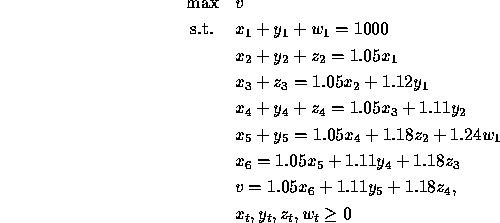We are going to manage an investment portfolio over a 6-year time horizon. We begin with $1000, and at various times we can invest in one or more of the following:
Savings account X, annual yield 5%.
Security Y, 2-year maturity, total yield 12% if bought now, 11% thereafter.
Security Z, 3-year maturity, total yield 18%.
Security W, 4-year maturity, total yield 24%.
To keep things simple we will assume that each security can be bought in any denomination. (This assumption can be relaxed if one uses integer or dynamic programming .) We can make savings deposits or withdrawals anytime. We can buy Security Y any year but year 3. We can buy Security Z anytime after the first year. Security W, now available, is a one-time opportunity.
We let ![]() be the amount of money invested in the savings
account X at the beginning of year t, and similarly for
be the amount of money invested in the savings
account X at the beginning of year t, and similarly for ![]() ,
, ![]() ,
and
,
and ![]() . We will put any money not tied up in securities into the
savings account. The situation is summed up in the figure.
. We will put any money not tied up in securities into the
savings account. The situation is summed up in the figure.

Figure 5.6: Possible investments over a 6-year horizon
The problem is really a kind of inventory problem. In a given year, the amount of money carried forward from the previous year (in savings), plus the yield from securities that mature that year, equals the amount invested in new securities plus the amount of money left over for next year. There is one twist: inventory grows while in storage. (In real inventory problems, stock often decreases over time due to spoilage, etc., and this can be reflected in negative ``interest'' rates.) Let v be the final yield when all securities are cashed in at the end of the sixth year. Then if the objective is to maximize final yield, the LP is,

The final assets come to $1387.6, an average annual yield of 5.61%